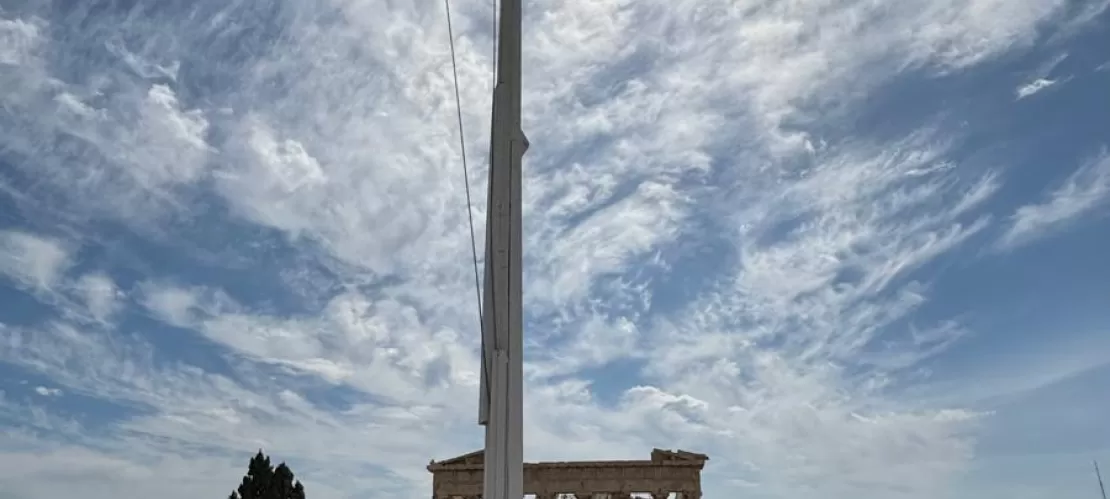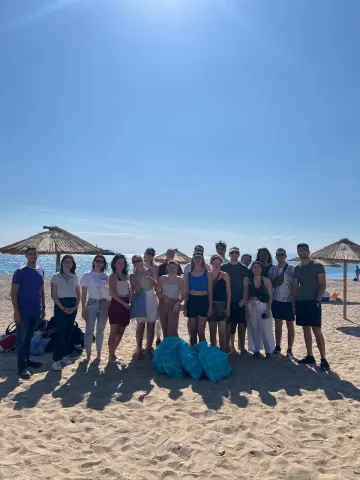
Hello again Erasmus Generation!
Today I want to tell you about my first experience during the Social Impact Days. Last Sunday (the 26th of May) at 6am a friend and I took a flight that brought us from Bologna straight to Athens.
It was my first time in Athens, and in general in Greece so, despite the tiredness, we were very excited and we started visiting the city.
Walking through the alleys I could feel all the history of the place mixed in with the modern lifestyle of the people.
The streets were full of shops and restaurants where they were selling traditional food and who am I to not try all of it?! We started with two souvlakis and saganaki (a fried cheese) for lunch. For dinner we started with fried feta with honey and fried rolls with feta and tomatoe sauce inside, followed by kalamari and octopus as main dishes. In the evening the atmosphere was completed by a couple that was playing an instrument (a sort of guitar but I don’t know the exact name) and singing Greek songs.
The second day of our staying, a member of ESN HARO brought us around the city showing us all of the important monuments there and told us the history of all of them. We went through the areas of Plaka and Monasteraki and we finished our tour at the Acropoli, visiting first the museum where are conserved many of the statues that were in the Parthenon, mainly to preserve them from the rain and other atmospheric events.
After visiting every floor of the museum, we started to climb the hill that brought us to the Parthenon, the main symbol of the city and of the nation. It’s so imponent even if there is just a part of it because the rest was destroyed during the centuries. Our buddy told us that Athens, during the centuries, was attacked by different empires and each of them tried to destroy something so now we can see the consequences of it. But they also tried to do reconstruction of a few parts to maintain structural integrity and it’s visible with the naked eyes because the fixings are wither than the original material.
From up there we had a 360° view of the city and, despite the fact the centre is small, the rest of Athens it’s very big in every direction. We could admire the mountains from one side and the sea on the other, and I think this is one of the best things that make the city very beautiful. Next to the Parthenon was hoisted a Greek flag and this represents an important symbol for the nation because during the second world war there was a nazi flag and a small group of students climbed up there to remove it. They were killed, sadly, but that action became a sign of freedom for the Greeks. But the flag is a symbol of freedom from the many occupations they had, and each of the nine lines of the flag represent a syllable of the slogan “freedom or death” in greek.
We finished the second day, after eating a traditional gyro, by going up again to the hill to admire the sunset. The colours that the sun was spreading on the city going behind the mountain left us breathless.
But don’t worry guys I didn’t go there just to eat and visit but most importantly to volunteer and that’s what I did my third - and last - day there.
We took the metro and then a bus to arrive in Glyfada, a sea area close to Athens. Here we met the volunteers and the Erasmus students of ESN HARO and ESN NTUA, the two sections involved in this event. Here, we went all together at the Archelon, the only sea turtles rehabilitation centre in Greece. Here volunteers from all over the world are focusing their efforts on healing this endangered species. At that moment they had 7 different species of turtles in the centre.
The guide explained to us how their aim is not only to rescue and take care of this animals, but also to improve their repopulation. She showed us all the tanks where they put the turtles during the recovery process. They have a covered area with smaller tanks for the first stadium of the rehabilitation process where they can give them medicines and they can observe them with more accuracy, then, once that the animals are better, they move them in the outside area. According to the necessities of each turtle, they can keep them in small thanks or big thanks. Normally the last one is used at the end of the period, before freeing them in the sea. Then she showed us different videos of their work, so how they act every day in there but also how they try to save the turtle’s eggs on the beach from the humans, because really often the mothers lay their eggs in beaches where people go to enjoy the good weather and there is the danger that an umbrella for example can hit them. Sometimes also the light of the cities are a problem so they create artificial path to the sea for the babies so when they come out of the sand they can find the way to the water.
This experience helped me opening my mind about this theme because I don’t leave close to the sea, so I don’t have many possibilities to do this type of activity.
When the visit finished, we moved on the next beach to clean it up. The organizers gave us gloves and rubbish bags and we started to look for plastic objects, cigarettes or any type of garbage. It’s incredible how many cigarettes and cans we found on the beach. And think that this was the third time the ESN section was doing this activity in that exact area.
At the end of the day, we just enjoyed a bit the beach before going to the airport and fly back home.
See you in my next adventure!!

